Exposure Range
If you walk into a room like this, you may see it as completely lit. A camera sees it differently.
Remember!
•Our eyes adjust to scenes way better than video
•In many cases with video like above you have to either choose between detail in the shadows or detail in the highlight area
•Standard to high definition video can have anywhere between 5 to 45 stops of contrast range or latitude. That means video can't adjust to images like the one above.
Histogram
While I do find myself using an incident light meter for certain things, I mainly save it for my work in motion picture film. My most preferred tool for monitoring exposure while I am shooting is the histogram.
Many higher end cameras have histogram readings on either the LCD or through the lens. For me, this simple diagram is usually all I need to know. As shown above, a histogram with all of its tonal information crammed to the right is overexposed and that very high line against the right frame of the top diagram shows that there is no highlight detail or is "clipped"
The middle is perfect as the diagram is not favoring either side of the frame and it would represent a video with a healthy variation of mid-tones and no loss of detail in the shadows and highlights.
The bottom frame shows an underexposed video with fewer midtones and no "light greys or whites present."
Above there is a well exposed photo in the middle and adding two stops on the right to overexpose and subtracting two stops on the left to underexpose.
I also use a waveform monitor, but mainly in post. One of the reasons why I do so, is because I shoot at a very low contrast profile and increase the contrast during the editing process. This allows me to bring out as much detail in the shadows and highlights as possible.
Above is a still from a film where I used that technique and below is an image of a standard wavefrom monitor.
Waveform Monitor above
If you want to bring the appropriate contrast out of your image, you bring up a waveform monitor in Adobe Premiere and in most cases set the blacks at "0" and the highlights at 100. My starting videos are so low contrast that they range from 20-70 and I adjust the highlights and shadows in premiere using color correction filters.





